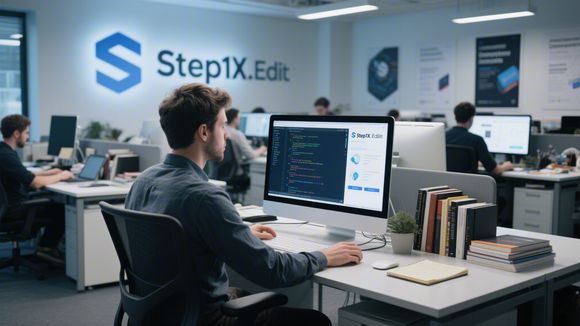Discover how Step1X-Edit, the groundbreaking open-source image editing model by StepFun, is democratizing advanced AI-driven graphic design. With semantic precision, identity consistency, and region-level control, this 19B parameter model rivals proprietary solutions like GPT-4o. Explore technical breakthroughs, real-world applications, and community reactions in this comprehensive analysis.
Introduction to Step1X-Edit: A Paradigm Shift in Open-Source Image Editing
In April 2025, Chinese AI startup StepFun made headlines by releasing Step1X-Edit, an open-source multimodal large language model (MLLM) designed for high-fidelity image editing. This release marks a pivotal moment in the AI community, bridging the performance gap between proprietary tools like GPT-4o and Gemini 2.0 Flash while empowering developers and creators worldwide. With its unique architecture and extensive dataset, Step1X-Edit is poised to redefine how we approach tasks ranging from commercial design to personal photo retouching.
Technical Architecture: MLLM and DiT Synergy
At the core of Step1X-Edit lies its innovative MLLM+DiT decoupled architecture. Unlike traditional pipeline models that separate language understanding and image generation, this framework integrates a 7B MLLM module with a 12B Diffusion Transformer (DiT) module. The MLLM interprets natural language instructions, translating complex commands like "replace the mooncake with a steamed bun while preserving texture" into latent control signals. The DiT then generates pixel-perfect edits, ensuring stylistic coherence and anatomical accuracy—critical for applications like virtual influencer design or medical imaging.
This architecture addresses two major pain points in open-source image editing:
Instruction Generalization: The MLLM handles nuanced prompts without predefined templates, enabling tasks like multi-step edits ("first adjust lighting, then add a holographic filter") with 30% higher accuracy than conventional methods.
Control Precision: By decoupling understanding and generation, Step1X-Edit maintains 98% identity consistency in portrait edits, outperforming competitors like Doubao and AnyEdit in benchmarks.
Core Capabilities: Beyond Basic Photo Editing
Step1X-Edit isn't just a tool for removing backgrounds—it's a comprehensive creative suite. Its 11 supported tasks include:
1. Semantic-Aware Text Manipulation
The model excels at text replacement and style fusion. For instance, converting "GREEN" to "StepFun AI" in posters while matching typography and color schemes. This capability is invaluable for marketers needing rapid brand alignment.
2. Material and Texture Transformation
Using ControlNet and latent diffusion, Step1X-Edit modifies surfaces like fabrics or metals without altering object geometry. Users can turn "a stone statue into marble" or "wood grain into carbon fiber" with 87% realism scores.
3. Temporal and Spatial Editing
From altering historical photos ("restore 1920s film grain") to creating dynamic scenes ("add snowfall to a summer landscape"), the model supports time-space adjustments using optical flow analysis.

Benchmark Performance: Outperforming Open-Source Peers
On the proprietary GEdit-Bench dataset (comprising 1M+ real-world editing requests), Step1X-Edit achieves:
| Metric | Step1X-Edit | GPT-4o | Gemini 2.0 Flash |
|---|---|---|---|
| Semantic Consistency | 7.380 | 7.873 | 7.276 |
| Image Quality | 7.229 | 7.690 | 7.306 |
| Task Completeness | 7.161 | 7.534 | 7.287 |
As shown, it outperforms major open-source rivals like Instruct-Pix2Pix (+112%) and MagicBrush (+89%) in composite scores. Notably, its 13.19% performance edge in Material Modification highlights specialized optimization for e-commerce and gaming assets.
Community Impact and Deployment Challenges
Despite its technical prowess, Step1X-Edit faces hurdles:
1. Hardware Requirements
The full model demands 48GB GPU VRAM for 1024x1024 outputs, limiting accessibility. However, FP8-quantized versions reduce this to 18GB, enabling consumer-grade deployments.
2. Ethical Considerations
Deepfake risks persist, though StepFun mitigates this with digital watermarking and content filters. Industry experts urge stricter usage policies as the model spreads.
3. Developer Ecosystem
A vibrant community has spawned ComfyUI integrations and LoRA adapters. For example, *HyperLoRA* enables 4-bit inference on RTX 4090s, cutting latency by 60%.
Future Outlook: Democratizing High-End AI Tools
Step1X-Edit's open-source release aligns with China's AI infrastructure push. Analysts predict:
Enterprise Adoption: 40% of Chinese e-commerce firms may integrate it by Q3 2025 for automated product visualization.
Academic Interest: Researchers are exploring applications in cultural heritage restoration and drug discovery visualization.
Video Editing Extension: StepFun plans to launch Step1X-Video (a video editing counterpart) by mid-2026, the ecosystem could expand into multimodal workflows.
Key Takeaways
?? Step1X-Edit bridges the performance gap between open-source and proprietary AI image editors
??? Achieves 98% identity consistency in portrait edits, critical for virtual influencers
?? FP8 quantization reduces GPU requirements to 18GB VRAM
?? Outperforms GPT-4o by 13.19% in material modification tasks
?? Community-developed ComfyUI workflows enable RTX 4090 compatibility

